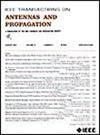An Ultracompact Shared-Radiator Electrically Small Huygens Dual-Circularly Polarized Antenna
IF 4.6
1区 计算机科学
Q1 ENGINEERING, ELECTRICAL & ELECTRONIC
引用次数: 0
Abstract
A novel electrically small shared-radiator Huygens dual-circularly polarized (HDCP) antenna is developed that features an ultracompact size, i.e.,一种超紧凑型共享辐射器电小型惠更斯双圆极化天线
开发了一种新型电小型共享散热器惠更斯双圆极化(HDCP)天线,具有超紧凑尺寸,即$\pi $ ($0.12\lambda _{\text {c}}$) ${}^{2} \times 0.06\lambda _{\text {c}} = 0.0027\lambda _{\text {c}}^{3}$ ($ka =0.78$),工作频率为915 MHz。共用辐射器由一对垂直放置的惠更斯线极化(HLP)天线组成。HDCP光束,即左手CP (LHCP)和右手CP (RHCP)惠更斯光束,可以同时被“8”形馈线作为驱动元件激发。为了补偿电感阻抗,开发了一种创新和紧凑的LC匹配网络,以匹配两个端口到标准50- $\Omega $传输线。样机的实测结果与仿真结果吻合较好。结果表明,两个输入端口之间的隔离度低于- 16 dB,测量(模拟)3 dB轴比(AR)波束宽度为120°(144°)。此外,LHCP和RHCP光束的峰值实现增益测量值是一致的,分别为2.8和2.6 dBic。作为一种超紧凑型双cp (DCP)天线,它是需要DCP性能和紧凑系统尺寸的无线应用的理想选择,例如,无电池物联网(IoT)生态系统,同时具有无线供电和数据传输。
本文章由计算机程序翻译,如有差异,请以英文原文为准。
求助全文
约1分钟内获得全文
求助全文
来源期刊
CiteScore
10.40
自引率
28.10%
发文量
968
审稿时长
4.7 months
期刊介绍:
IEEE Transactions on Antennas and Propagation includes theoretical and experimental advances in antennas, including design and development, and in the propagation of electromagnetic waves, including scattering, diffraction, and interaction with continuous media; and applications pertaining to antennas and propagation, such as remote sensing, applied optics, and millimeter and submillimeter wave techniques

 求助内容:
求助内容: 应助结果提醒方式:
应助结果提醒方式:


